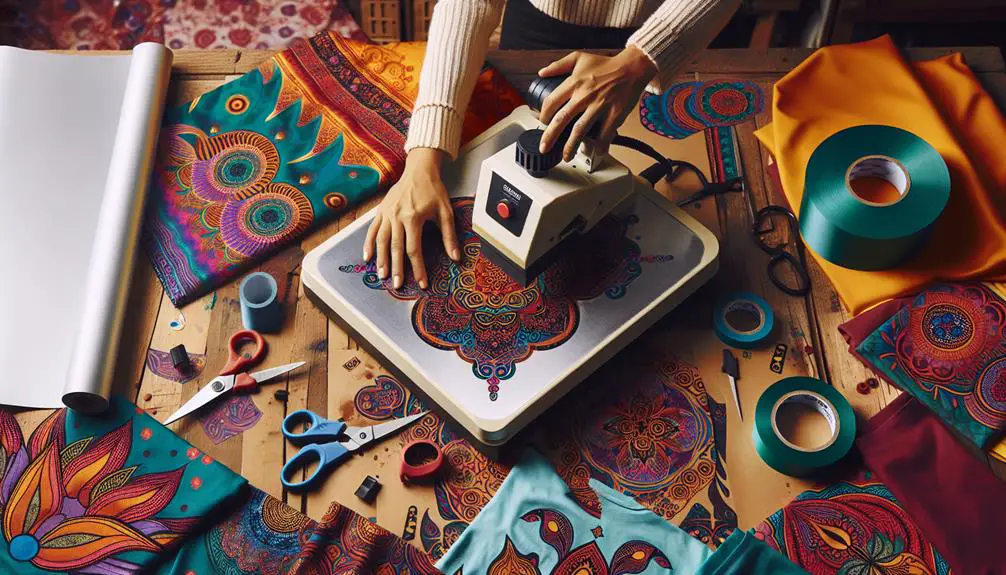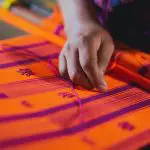When you're starting with heat transfer printing, you'll want to focus on a few key techniques to set yourself up for success. Investing in a quality heat press and transfer paper is vital, but you also need to understand how different fabrics react to heat. For example, cotton and polyester each have their own quirks. Preparing your design with attention to color and detail is equally significant. We'll go over how to adjust heat and pressure settings, pre-press fabric, and troubleshoot common problems such as poor ink adhesion. Curious about achieving vibrant, long-lasting designs? Let's explore these fundamentals further.
Table of Contents
Key Takeaways
- Use a high-quality heat press with adjustable temperature and pressure settings.
- Select transfer paper designed for the specific fabric you are using.
- Ensure your design is a high-quality format and test a small sample for color accuracy.
- Pre-press the fabric to remove wrinkles and moisture before applying the transfer.
- Maintain consistent temperature and pressure to avoid design lifting or peeling.
Essential Equipment
To start heat transfer printing, you'll need a few essential pieces of equipment to guarantee your designs come out perfectly. First and foremost, invest in a high-quality heat press. This machine applies the necessary pressure and heat to transfer your design from transfer paper onto your chosen substrate. The heat press is the backbone of your operation, so selecting one with adjustable temperature and pressure settings is important for achieving best results.
Next, you'll need transfer paper specifically designed for heat transfer printing. This special paper holds your printed design and releases it onto the fabric when heat and pressure are applied. There are different types of transfer paper for various fabrics, so be sure to choose the correct one for your project. Mastery in heat transfer printing involves understanding the nuances of different transfer papers and how they interact with your heat press settings.
Additionally, you might consider having a few supplementary tools on hand, such as a pair of heat-resistant gloves and a Teflon sheet. These items can help protect your hands and ensure even heat distribution, respectively.
With the right equipment, you'll be well on your way to producing professional-quality heat transfer prints.
Choosing the Right Materials
Selecting the right materials is crucial for ensuring your heat transfer prints look professional and last long. The first step is understanding material compatibility. Not all fabrics are created equal, and some respond better to heat transfer printing than others. Pay close attention to the manufacturer's recommendations for heat settings to avoid damaging your fabric.
Fabric selection is another vital factor. Choose fabrics known for their color fastness, as this will guarantee that your prints remain vibrant through multiple washes. Ideal materials include:
- Cotton: Offers excellent color retention and is highly compatible with most heat settings.
- Polyester: Works well but requires careful heat management to avoid melting.
- Blends: Cotton-polyester blends provide a balance of durability and color fastness.
- Specialty Fabrics: These may require unique heat settings and should be tested beforehand.
Your fabric's color fastness will directly impact the longevity of your prints. Always conduct a small test print to gauge how well the material holds up under heat. High-quality materials combined with the right heat settings will give you the best results, making your designs stand out and last.
Preparing Your Design
Once you've chosen the right materials, it's time to focus on preparing your design to guarantee it transfers perfectly onto your fabric. Start by deciding on the design placement. It's essential to determine where exactly on the fabric you want your design. Measure and mark the area to confirm precision and symmetry, especially if you're working with multiple items or large prints.
Next, color selection plays a significant role in the final outcome. Choose colors that will stand out against the fabric and complement each other. Keep in mind that some colors may appear different after they're transferred, so always test a small sample if possible. Make sure your design is in a high-quality format to avoid any pixelation issues when it's enlarged.
Additionally, consider the type of fabric you're working with, as it can impact both design placement and color vibrancy. Different fabrics absorb dyes in various ways, so adjust your design accordingly.
Applying Heat and Pressure
Applying the correct amount of heat and pressure is crucial for achieving a flawless transfer and guaranteeing your design adheres properly to the fabric. Mastering temperature control and proper techniques will enhance your heat transfer printing skills.
First, set your heat press to the recommended temperature for your particular transfer material. Most materials require a range of 300-350°F, but always check the manufacturer's guidelines.
When you're ready to press, make sure the fabric is spread evenly without any wrinkles. This prevents uneven transfers and secures the design bonds well. Here's a quick checklist to guide you:
- Temperature control: Set the heat press to the precise temperature specified for your material.
- Pressure application: Adjust the pressure according to the fabric type—lighter for delicate fabrics, heavier for thicker materials.
- Pre-press fabric: Briefly press the fabric to eliminate moisture and wrinkles before applying the design.
- Timely pressing: Follow the recommended pressing time, usually around 10-15 seconds, but always refer to your material's instructions.
Maintaining consistent temperature control and using proper techniques ensures a professional result.
Don't rush the process; patience and precision are key. With practice, you'll achieve crisp, vibrant transfers that withstand the test of time.
Troubleshooting Common Issues
Even with meticulous attention to heat and pressure, you might still encounter some common issues in heat transfer printing.
One frequent problem is poor ink adhesion. If your design isn't sticking well to the fabric, check the type of ink and material compatibility. Certain inks bond better with specific fabrics, so make sure you're using the right combination. Additionally, verify the surface is clean and free from contaminants like dust or oil, which can impede adhesion.
Another common issue is temperature fluctuations. Consistent temperature is essential for effective transfers. If your heat press isn't maintaining a steady temperature, your results will vary. Use a reliable thermometer to verify the press's accuracy. If discrepancies arise, recalibrate your machine or consider investing in a higher-quality press.
Uneven pressure can cause parts of the design to lift or peel. Make sure the pressure setting is uniform across the entire surface. If you're using a multi-layer design, each layer must receive equal pressure to guarantee seamless adhesion.
Frequently Asked Questions
How Do I Maintain My Heat Transfer Printing Equipment?
To sustain your heat transfer printing equipment, use these maintenance tips: regularly inspect for wear, troubleshoot any issues promptly, and apply proper cleaning techniques. Prioritize equipment care to extend its life and guarantee peak performance.
What Safety Precautions Should I Take During the Printing Process?
Think of your workspace as a fortress of safety. Guarantee proper ventilation and wear protective gear. Prioritize fire prevention by keeping flammables away and maintaining your equipment regularly. Mastery comes from respecting these essential safety precautions.
Can I Use Heat Transfer Printing on Non-Fabric Materials?
Yes, you can use heat transfer printing on non-fabric materials like metal surfaces and wood projects. Make sure you select the right type of transfer paper and adjust your technique to accommodate the material's unique properties.
How Do I Store Unused Heat Transfer Materials?
When storing materials, keep them in a cool, dry place, away from sunlight. Use airtight containers to prevent damage from moisture and dust. Confirm they're flat, not rolled, to avoid creases and maintain quality.
What Are the Environmental Impacts of Heat Transfer Printing?
You should consider the environmental impacts of heat transfer printing, particularly energy consumption and waste disposal. This process can increase your carbon footprint and raise pollution concerns, so it's important to adopt eco-friendly practices.
- How Does Ring Spun Cotton Affect Garment Fit and Shape Retention? - August 13, 2024
- What Are the Challenges in Producing Ring Spun Cotton? - August 13, 2024
- Is Ring Spun Cotton Suitable for Plus-Size Clothing? - August 13, 2024







